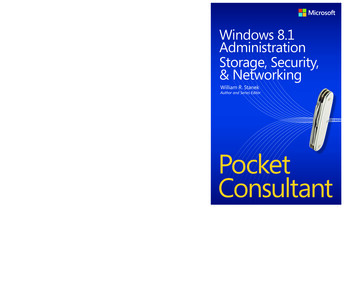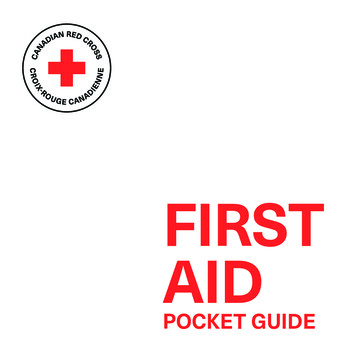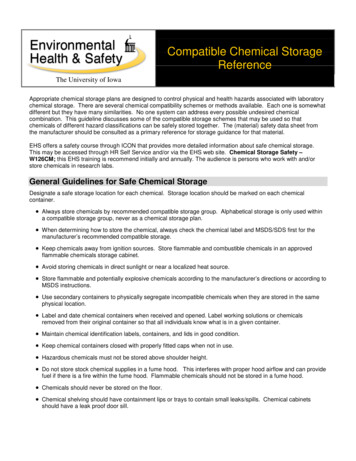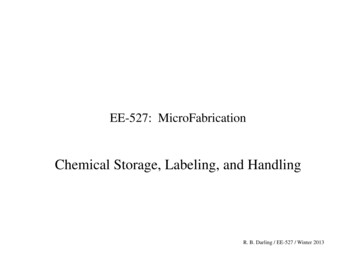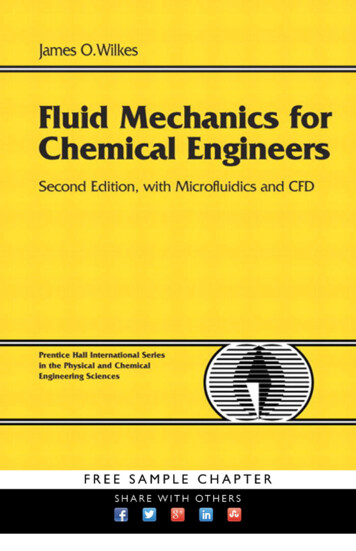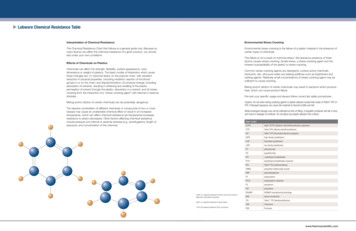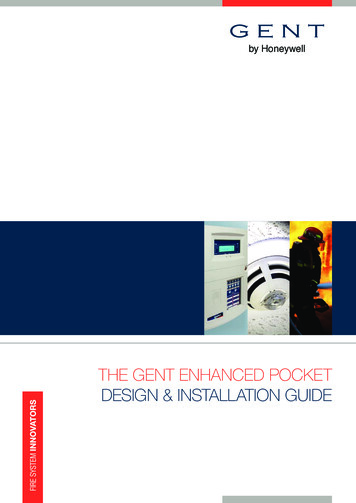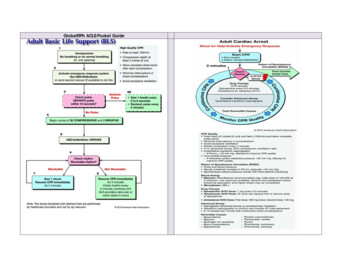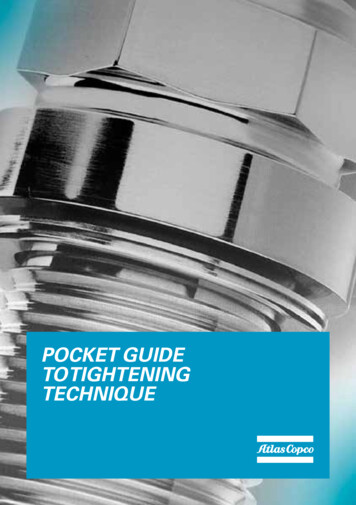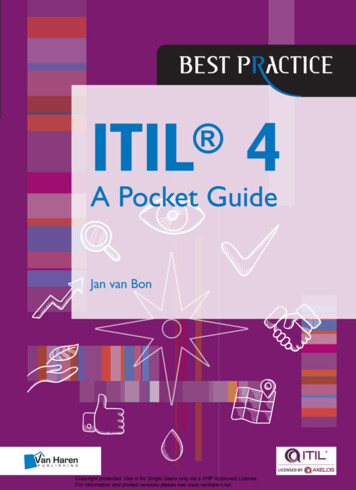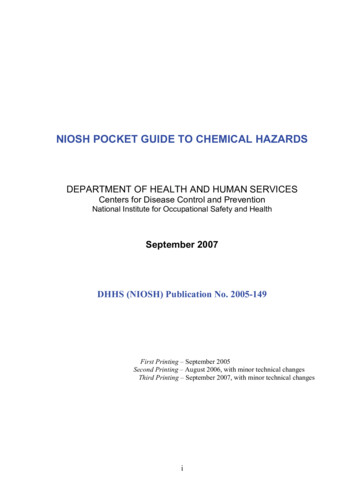
Transcription
NIOSH POCKET GUIDE TO CHEMICAL HAZARDSDEPARTMENT OF HEALTH AND HUMAN SERVICESCenters for Disease Control and PreventionNational Institute for Occupational Safety and HealthSeptember 2007DHHS (NIOSH) Publication No. 2005-149First Printing – September 2005Second Printing – August 2006, with minor technical changesThird Printing – September 2007, with minor technical changesi
DISCLAIMERMention of the name of any company or product does not constitute endorsement by theNational Institute for Occupational Safety and Health (NIOSH). In addition, citations toWeb sites external to NIOSH do not constitute NIOSH endorsement of the sponsoringorganizations or their programs or products. Furthermore, NIOSH is not responsible for thecontent of these Web sites.ORDERING INFORMATIONTo receive documents or other information about occupationalsafety and health topics, contact NIOSH at:Telephone: 1-800-CDC-INFO (1-800-232-4636)TTY: 1-888-232-6348E-mail: cdcinfo@cdc.govNIOSH Web site: http://www.cdc.gov/nioshFor a monthly update on news at NIOSH, subscribe toNIOSH eNews by visiting www.cdc.gov/niosh/eNews.For sale by:Superintendent of DocumentsU.S. Government Printing OfficeP.O. Box 371954Pittsburgh, PA 15250-7954National Technical Information Service5285 Port Royal RoadSpringfield, VA 22161Telephone: (703) 605-6000GPO stock number: 017-033-00500-1Internet: http://bookstore.gpo.govTelephone: (202) 512-1800Toll-free telephone: (866) 512-1800Fax: (202) 512-2104NTIS stock number: PB2005-108099Internet: http://www.ntis.govTelephone: (703) 605-6000Toll-free telephone: (800) 553-6847This document is in the public domain andmay be freely copied or reprinted.SAFER HEALTHIER PEOPLE ii
ELECTRONIC VERSIONSThe Pocket Guide is available in CD-ROM format from NIOSH and is on the NIOSH Website (http://www.cdc.gov/niosh/npg/npg.html). Further information about these electronicversions, or about copies of this and other NIOSH documents, may be obtained from theoffice listed below:NIOSH Publications4676 Columbia ParkwayCincinnati, Ohio 45226-1998Toll-free telephone: (800) 356-4674Fax: (513) 533-8573The Pocket Guide is also made available through commercial vendors in electronic formats.It is currently available in CD-ROM format from the vendors listed below. Please contactthem directly to receive more detailed information, including the prices of their products.Canadian Centre forOccupational Health and SafetyHamilton, Ontario, CanadaToll-free telephone: (800) 668-4284Fax: (905) 572-2206Praxis Environmental Systems, Inc.Guilford, ConnecticutTelephone: (203) 458-7111Fax: (203) 458-7121Micromedex, Inc.Englewood, ColoradoToll-free telephone: (800) 525-9083Fax: (800) 635-6339Industrial Hygiene Services, Inc.St. Louis, MissouriToll-free telephone: (800) 732-3015Fax: (314) 726-6361Tecsa S.p.A.Italy (portion in Italian)Telephone: 39 2 33910.484Fax: 39 2 33910.737Emergency Response Specialists, Inc.Birmingham, AlabamaTelephone: (205) 324-0100COMMENTS & SUGGESTIONSWe encourage and welcome any comments, suggestions, or corrections that you may haveregarding the Pocket Guide. You can use the Reader Response Card included with thePocket Guide, or you can contact us via e-mail or telephone. Thank you for your commentsand suggestions.E-mail address: npgcomments@cdc.govToll-free telephone: (800) 356-4674iii
PREFACEThe NIOSH Pocket Guide to Chemical Hazards presents information taken from theNIOSH/OSHA Occupational Health Guidelines for Chemical Hazards, from NationalInstitute for Occupational Safety and Health (NIOSH) criteria documents and CurrentIntelligence Bulletins, and from recognized references in the fields of industrial hygiene,occupational medicine, toxicology, and analytical chemistry. The information is presentedin tabular form to provide a quick, convenient source of information on general industrialhygiene practices. The information in the Pocket Guide includes chemical structures orformulas, identification codes, synonyms, exposure limits, chemical and physicalproperties, incompatibilities and reactivities, measurement methods, respirator selections,signs and symptoms of exposure, and procedures for emergency treatment.The information assembled in the original 1978 printing of the Pocket Guide was the resultof the Standards Completion Program, a joint effort by NIOSH and the Department ofLabor to develop supplemental requirements for the approximately 380 workplaceenvironmental exposure standards adopted by the Occupational Safety and HealthAdministration (OSHA) in 1971.Listed below are changes that were made for this edition (2005-149) of the Pocket Guide: New layout for the Chemical Listing section. Recommendations for particulate respirators have been revised to incorporate“Part 84” terminology. See “Recommendations for Respirator Selection” on pagexiv for a more thorough explanation of these changes. The Synonym and Trade Name Index has been expanded. This index is nowcalled the Chemical, Synonym, and Trade Name Index (page 383). Some ID and Guide Numbers were changed to reflect changes made in the 2004Emergency Response Guidebook (http://hazmat.dot.gov/pubs/erg/gydebook.htm). Appendix E (page 351) has been revised. It now contains OSHA respiratorrequirements for 28 chemicals or hazardous substances that were identified in thepreamble to the OSHA Respiratory Protection Standard (29 CFR 1910.134). Other minor technical changes have also been made since the February 2004edition. (For the most current information and updates, consult the electronicversion on the NIOSH Web site: http://www.cdc.gov/niosh/npg/npg.html.)Listed below are changes made for the 3rd printing of this edition of the Pocket Guide: Changes were made to reflect the new OSHA PEL for hexavalent chromium. The NIOSH REL for coal mine dust was added to the coal dust entry. A few other minor technical changes have been made.iv
CONTENTSPreface .ivAcknowledgments .viIntroduction .viiNIOSH Recommendations .viiHow to Use This Pocket Guide .viiiTable 1 – NIOSH Manual of Analytical Methods .xviiTable 2 – Personal Protection and Sanitation Codes .xviiiTable 3 – Symbols, Code Components, and Codes Used for Respirator Selection .xxTable 4 – Selection of N-, R-, or P-Series Particulate Respirators .xxvTable 5 – Abbreviations for Exposure Routes, Symptoms, and Target Organs .xxviTable 6 – Codes for First Aid Data . xxviiiChemical Listing .1Appendices .341Appendix A – NIOSH Potential Occupational Carcinogens .342Appendix B – Thirteen OSHA-Regulated Carcinogens .344Appendix C – Supplementary Exposure Limits .345Appendix D – Substances with No Established RELs .350Appendix E – OSHA Respirator Requirements for Selected Chemicals .351Appendix F – Miscellaneous Notes .361Appendix G – Vacated 1989 OSHA PELs .362Indices .373CAS Number Index .374DOT ID Number Index .379Chemical, Synonym, and Trade Name Index .383v
ACKNOWLEDGMENTSThe Education and Information Division (EID), National Institute for OccupationalSafety and Health (NIOSH), has primary responsibility for the development of the PocketGuide. There have been many people who have contributed to the preparation anddevelopment of this document since it was first published in 1978. I would like to expressmy appreciation to the following people within EID for their efforts: Vern Anderson forgeneral guidance; Guss Hasbani (Constella Group, Inc.) for computer programming anddatabase development that has been vital to the production of this new edition;Heinz Ahlers, Barb Dames, Charles Geraci, Richard Niemeier, David Votaw,Alan Weinrich, and Ralph Zumwalde for policy review; David Case, Laura Delaney, andRolland Rogers for reformatting and computerization; Vanessa Becks, Anne Hamilton, andRodger Tatken for editorial review; Clayton Doak, Eileen Kuempel, Leela Murthy, HenrykaNagy, John Palassis, Faye Rice, and David Votaw for assistance in updating and addinginformation; Lawrence Foster, Vicki Reuss, Lucy Schoolfield, and Ronald Schuler for dataacquisition; Kent Hatfield for consultation on toxicology issues; Charlene Maloney forpublication dissemination and general guidance; and Oliver F. Cobb and Associates (CarlaBrooks, George Brown, Sherri Diana, and Jesse Romans) for answering requests andmailing thousands of copies of the Pocket Guide.The following people, who constitute the Pocket Guide Editorial Board, havecontributed greatly by providing guidance and review of the content and style of thisnew edition: Steven Ahrenholz (Division of Surveillance, Hazard Evaluations and FieldStudies, DSHEFS), Roland BerryAnn (National Personal Protective TechnologyLaboratory, NPPTL), Joseph Bowman (Division of Applied Research and Technology,DART), Pamela Drake (Spokane Research Laboratory, SRL), Gerald Joy (PittsburghResearch Laboratory, PRL), Alan Lunsford (DART), Nancy Nilsen (DSHEFS),Paula Fey O’Connor (DART), Carl Ornot (Office of Administrative and ManagementServices, OAMS), Jay Snyder (NPPTL), Sidney Soderholm (Health Effects LaboratoryDivision, HELD), David Sylvain (DSHEFS), Ainsley Weston (HELD), andAnthony Zimmer (DART).In addition, the following people also have contributed greatly to the Pocket Guide:Mary Ellen Cassinelli (DART), Donald Dollberg (DART), and Paula Fey O’Connor(DART) for the development of the measurement methods section; Roland BerryAnn(NPPTL), Nancy Bollinger (HELD), Christopher Coffey (Division of Respiratory DiseaseStudies, DRDS) for the development of respirator recommendations; Laurence Reed(DART) and John Whalen (DART) for policy review; Crystal Ellison (Office ofCompensation Analysis and Support, OCAS) for assistance in updating and addinginformation; and Henry Chan and Howard Ludwig (former Pocket Guide Technical Editors)for general guidance.Also, thanks are due to all of the people who have reviewed and commented on thePocket Guide during its initial development and subsequent revisions.Michael E. Barsan(Technical Editor)vi
INTRODUCTIONThe NIOSH Pocket Guide to Chemical Hazards provides a concise source of generalindustrial hygiene information for workers, employers, and occupational healthprofessionals. The Pocket Guide presents key information and data in abbreviated tabularform for 677 chemicals or substance groupings commonly found in the work environment(e.g., manganese compounds, tellurium compounds, inorganic tin compounds, etc.). Theindustrial hygiene information found in the Pocket Guide assists users to recognize andcontrol occupational chemical hazards. The chemicals or substances contained in thisrevision include all substances for which the National Institute for Occupational Safety andHealth (NIOSH) has recommended exposure limits (RELs) and those with permissibleexposure limits (PELs) as found in the Occupational Safety and Health Administration(OSHA) Occupational Safety and Health Standards (29 CFR 1910.1000 – 1052).BackgroundIn 1974, NIOSH (which is responsible for recommending health and safety standards)joined OSHA (whose jurisdictions include promulgation and enforcement activities) indeveloping a series of occupational health standards for substances with existing PELs.This joint effort was labeled the Standards Completion Program and involved thecooperative efforts of several contractors and personnel from various divisions withinNIOSH and OSHA. The Standards Completion Program developed 380 substance-specificdraft standards with supporting documentation that contained technical information andrecommendations needed for the promulgation of new occupational health regulations. ThePocket Guide was developed to make the technical information in those draft standardsmore conveniently available to workers, employers, and occupational health professionals.The Pocket Guide is updated periodically to reflect new data regarding the toxicity ofvarious substances and any changes in exposure standards or recommendations. (For themost current information and updates, consult the electronic version on the NIOSH Website: http://www.cdc.gov/niosh/npg/npg.html.)Data Collection and ApplicationThe data collected for this revision were derived from a variety of sources, includingNIOSH policy documents such as Criteria Documents and Current Intelligence Bulletins(CIBs), and recognized references in the fields of industrial hygiene, occupational medicine,toxicology, and analytical chemistry.NIOSH RECOMMENDATIONSActing under the authority of the Occupational Safety and Health Act of 1970 (29 USCChapter 15) and the Federal Mine Safety and Health Act of 1977 (30 USC Chapter 22),NIOSH develops and periodically revises recommended exposure limits (RELs) forhazardous substances or conditions in the workplace. NIOSH also recommends appropriatepreventive measures to reduce or eliminate the adverse health and safety effects of thesevii
hazards. To formulate these recommendations, NIOSH evaluates all known and availablemedical, biological, engineering, chemical, trade, and other information relevant to thehazard. These recommendations are then published and transmitted to OSHA and the MineSafety and Health Administration (MSHA) for use in promulgating legal standards.NIOSH recommendations are published in a variety of documents. Criteria documentsrecommend workplace exposure limits and appropriate preventive measures to reduce oreliminate adverse health effects and accidental injuries.Current Intelligence Bulletins (CIBs) are issued to disseminate new scientific informationabout occupational hazards. A CIB may draw attention to a formerly unrecognized hazard,report new data on a known hazard, or present information on hazard control.Alerts, Special Hazard Reviews, Occupational Hazard Assessments, and TechnicalGuidelines support and complement the other standard development activities of theInstitute. Their purpose is to assess the safety and health problems associated with a givenagent or hazard (e.g., the potential for injury or for carcinogenic, mutagenic, or teratogeniceffects) and to recommend appropriate control and surveillance methods. Although thesedocuments are not intended to supplant the more comprehensive criteria documents, theyare prepared in order to assist OSHA and MSHA in the formulation of regulations.In addition to these publications, NIOSH periodically presents testimony before variousCongressional committees and at OSHA and MSHA rulemaking hearings.Recommendations made through 1992 are available in a single compendium entitledNIOSH Recommendations for Occupational Safety and Health: Compendium of PolicyDocuments and Statements [DHHS (NIOSH) Publication No. 92-100](http://www.cdc.gov/niosh/92-100.html). More recent recommendations are available onthe NIOSH Web site (http://www.cdc.gov/niosh). Copies of the Compendium may beordered from the NIOSH Publications office (800-356-4674).HOW TO USE THIS POCKET GUIDEThe Pocket Guide has been designed to provide chemical-specific data to supplementgeneral industrial hygiene knowledge. Individual tables for each chemical present this datain the Chemical Listing section (page 1). To maximize the amount of data provided in thelimited space in these tables, abbreviations and codes have been used extensively. Theseabbreviations and codes, which have been designed to permit rapid comprehension by theregular user, are discussed for each field in these chemical tables in the followingsubsections.Chemical NameThe chemical name found in the OSHA General Industry Air Contaminants Standard (29CFR 1910.1000) is listed in the blue box in the top left portion of each chemical table. Thisname is referred to as the “primary name” in the Chemical, Synonym, and Trade NameIndex (page 383).viii
Structure/FormulaThe chemical structure or formula is listed in the field to the right of the chemical name ineach chemical table. Carbon-carbon double bonds (-C C-) and carbon-carbon triple bonds(-C C-) have been indicated where applicable.CAS NumberThis section lists the Chemical Abstracts Service (CAS) registry number. The CASnumber, in the format xxx-xx-x, is unique for each chemical and allows efficient searchingon computerized data bases. A page index for all CAS registry numbers listed is includedat the back of the Pocket Guide (page 374) to help the user locate a specific substance.RTECS NumberThis section lists the NIOSH Registry of Toxic Effects of Chemical Substances (RTECS )number, in the format ABxxxxxxx. RTECS may be useful for obtaining additionaltoxicologic information on a specific substance.RTECS is a compendium of data extracted from the open scientific literature. OnDecember 18, 2001, CDC’s Technology Transfer Office, on behalf of NIOSH, successfullycompleted negotiating a “PHS Trademark Licensing Agreement” for RTECS . This nonexclusive licensing agreement provides for the transfer and continued development of the“RTECS database and its trademark” to MDL Information Systems, Inc. (MDL), a whollyowned subsidiary of Elsevier Science, Inc. Under this agreement, MDL will be responsiblefor updating, licensing, marketing, and distributing RTECS . For more information visitthe MDL Web site (http://www.mdli.com).The RTECS entries for chemicals listed in the Pocket Guide can be viewed on the NIOSHWeb site (http://www.cdc.gov/niosh/npg/npg.html) or on the CD-ROM version of thePocket Guide (see page iii for ordering information).IDLHThis section lists the immediately dangerous to life or health concentrations (IDLHs). Forthe June 1994 Edition of the Pocket Guide, NIOSH reviewed and in many cases revised theIDLH values. The criteria utilized to determine the adequacy of the original IDLH valueswere a combination of those used during the Standards Completion Program and a newermethodology developed by NIOSH. These “interim” criteria formed a tiered approach,preferentially using acute human toxicity data, followed by acute animal inhalation toxicitydata, and then by acute animal oral toxicity data to determine a preliminary updated IDLHvalue. When relevant acute toxicity data were insufficient or unavailable, NIOSH alsoconsidered using chronic toxicity data or an analogy to a chemically similar substance.NIOSH then compared these preliminary values with the following criteria to determine theupdated IDLH value: 10% of lower explosive limit (LEL); acute animal respiratoryirritation data (RD50); other short-term exposure guidelines; and the NIOSH RespiratorSelection Logic (DHHS [NIOSH] Publication No. 2005-100;ix
http://www.cdc.gov/niosh/docs/2005-100). The Documentation for ImmediatelyDangerous to Life or Health Concentrations (NTIS Publication Number PB-94-195047)further describes these criteria and provides information sources for both the original andrevised IDLH values (http://www.cdc.gov/niosh/idlh/idlh-1.html). NIOSH currently isassessing the various uses of IDLHs, whether the criteria used to derive the IDLH valuesare valid, and if other information or criteria should be utilized.The purpose for establishing an IDLH value in the Standards Completion Program was todetermine the airborne concentration from which a worker could escape without injury orirreversible health effects from an IDLH exposure in the event of the failure of respiratoryprotection equipment. The IDLH was considered a maximum concentration above whichonly a highly reliable breathing apparatus providing maximum worker protection should bepermitted. In determining IDLH values, NIOSH considered the ability of a worker toescape without loss of life or irreversible health effects along with certain transient effects,such as severe eye or respiratory irritation, disorientation, and incoordination, which couldprevent escape. As a safety margin, IDLH values are based on effects that might occur as aconsequence of a 30-minute exposure. However, the 30-minute period was NOT meant toimply that workers should stay in the work environment any longer than necessary; in fact,EVERY EFFORT SHOULD BE MADE TO EXIT IMMEDIATELY!The NIOSH Respirator Selection Logic defines IDLH exposure conditions as “conditionsthat pose an immediate threat to life or health, or conditions that pose an immediate threatof severe exposure to contaminants, such as radioactive materials, which are likely to haveadverse cumulative or delayed effects on health.” The purpose of establishing an IDLHexposure concentration is to ensure that the worker can escape from a given contaminatedenvironment in the event of failure of the respiratory protection equipment. The RespiratorSelection Logic uses IDLH values as one of several respirator selection criteria. Under theRespirator Selection Logic, the most protective respirators (e.g., a self-contained breathingapparatus equipped with a full facepiece and operated in a pressure-demand or otherpositive-pressure mode) would be selected for firefighting, exposure to carcinogens, entryinto oxygen-deficient atmospheres, in emergency situations, during entry into anatmosphere that contains a substance at a concentration greater than 2,000 times the NIOSHREL or OSHA PEL, and for entry into IDLH atmospheres. IDLH values are listed in thePocket Guide for over 380 substances.The notation “Ca” appears in the IDLH field for all substances that NIOSH considerspotential occupational carcinogens. However, IDLH values that were originally determinedin the Standards Completion Program or were subsequently revised are shown in bracketsfollowing the “Ca” designations. “10%LEL” indicates that the IDLH was based on 10%of the lower explosive limit for safety considerations even though the relevant toxicologicaldata indicated that irreversible health effects or impairment of escape existed only at higherconcentrations. “N.D.” indicates that an IDLH value has not been determined for thatsubstance. Appendix F (page 361) contains an explanation of the “Effective” IDLHs usedfor four chloronaphthalene compounds.x
Conversion FactorsThis section lists factors for the conversion of ppm (parts of vapor or gas per million partsof contaminated air by volume) to mg/m3 (milligrams of vapor or gas per cubic meter ofcontaminated air) at 25 C and 1 atmosphere for chemicals with exposure limits expressed inppm.DOT ID and Guide NumberThis section lists the U.S. Department of Transportation (DOT) Identification numbers andthe corresponding Guide numbers. Their format is xxxx yyy. The Identification (ID)number (xxxx) indicates that the chemical is regulated by DOT. The Guide number (yyy)refers to actions to be taken to stabilize an emergency situation; this information can befound in the 2004 Emergency Response Guidebook (Office of Hazardous MaterialsInitiatives and Training [DHM-50], Research and Special Programs Administration, U.S.Department of Transportation, 400 7th Street, S.W., Washington, D.C. 20590-0001; for saleby the U.S. Government Printing Office, Superintendent of Documents, P.O. Box 371954,Pittsburgh, PA 15250-7954). This information is also available on the CD-ROM and Website versions of the Pocket Guide (http://www.cdc.gov/niosh/npg/npg.html). A page indexfor all DOT ID numbers listed is provided on page 379 to help the user locate a specificsubstance; please note however, that many DOT numbers are not unique for a specificsubstance.Synonyms and Trade NamesThis section contains an alphabetical list of common synonyms and trade names for eachchemical. A page index for all chemical names, synonyms, and trade names listed in thePocket Guide is included on page 383.Exposure LimitsThe NIOSH recommended exposure limits (RELs) are listed first in this section. ForNIOSH RELs, “TWA” indicates a time-weighted average concentration for up to a 10-hourworkday during a 40-hour workweek. A short-term exposure limit (STEL) is designated by“ST” preceding the value; unless noted otherwise, the STEL is a 15-minute TWA exposurethat should not be exceeded at any time during a workday. A ceiling REL is designated by“C” preceding the value; unless noted otherwise, the ceiling value should not be exceededat any time. Any substance that NIOSH considers to be a potential occupational carcinogenis designated by the notation “Ca” (see Appendix A [page 342], which contains a briefdiscussion of potential occupational carcinogens).The OSHA permissible exposure limits (PELs), as found in Tables Z-1, Z-2, and Z-3 of theOSHA General Industry Air Contaminants Standard (29 CFR 1910.1000), that wereeffective on July 1, 1993* and which are currently enforced by OSHA are listed next.*In July 1992, the 11th Circuit Court of Appeals in its decision inAFL-CIO v. OSHA, 965 F.2d 962 (11th Cir., 1992) vacated more protectivePELs set by OSHA in 1989 for 212 substances, moving them back to PELsxi
established in 1971. The appeals court also vacated new PELs for 164substances that were not previously regulated. Enforcement of the courtdecision began on June 30, 1993. Although OSHA is currently enforcingexposure limits in Tables Z-1, Z-2, and Z-3 of 29 CFR 1910.1000 whichwere in effect before 1989, violations of the “general duty clause” ascontained in Section 5(a) (1) of the Occupational Safety and Health Actmay be considered when worker exposures exceed the 1989 PELs for the164 substances that were not previously regulated. The substances forwhich OSHA PELs were vacated on June 30, 1993 are indicated by thesymbol “†” following OSHA in this section and previous values (the PELsthat were vacated) are listed in Appendix G (page 362).TWA concentrations for OSHA PELs must not be exceeded during any 8-hour workshift ofa 40-hour workweek. A STEL is designated by “ST” preceding the value and is measuredover a 15-minute period unless noted otherwise. OSHA ceiling concentrations (designatedby “C” preceding the value) must not be exceeded during any part of the workday; ifinstantaneous monitoring is not feasible, the ceiling must be assessed as a15-minute TWA exposure. In addition, there are a number of substances from Table Z-2(e.g., beryllium, ethylene dibromide) that have PEL ceiling values that must not beexceeded except for specified excursions. For example, a “5-minute maximum peak in any2 hours” means that a 5-minute exposure above the ceiling value, but never above themaximum peak, is allowed in any 2 hours during an 8-hour workday. Appendix B (page344) contains a brief discussion of substances regulated as carcinogens by OSHA.Concentrations are given in ppm, mg/m3, mppcf (millions of particles per cubic foot of airas determined from counting an impinger sample), or fibers/cm3 (fibers per cubiccentimeter). The “[skin]” designation indicates the potential for dermal absorption; skinexposure should be prevented as necessary through the use of good work practices, gloves,coveralls, goggles, and other appropriate equipment. The “(total)” designation indicatesthat the REL or PEL listed is for "total particulate" versus the “(resp)” designation whichrefers to the “respirable fraction” of the airborne particulate.Appendix C (page 345) contains more detailed discussions of the specific exposure limitsfor certain low-molecular-weight aldehydes, asbestos, various dyes (benzidine-, o-tolidine-,and o-dianisidine-based), carbon black, chloroethanes, the various chromium compounds(chromic acid and chromates, chromium(II) and chromium(III) compounds, and chromiummetal), coal tar pitch volatiles, coke oven emissions, cotton dust, lead, mineral dusts,NIAX Catalyst ESN, trichloroethylene, and tungsten carbide (cemented). Appendix D(page 350) contains a brief discussion of substances included in the Pocket Guide with noestablished RELs at this time. Appendix F (page 361) contains miscellaneous notesregarding the OSHA PEL for benzene, and Appendix G (page 362) lists the OSHA PELSthat were vacated on June 30, 1993.Measurement MethodsThe section provides a source (NIOSH or OSHA) and the corresponding method numberfor measurement methods which can be used to determine the exposure for the chemical orxii
substance. Unless otherwise noted, the NIOSH methods are from the 4th edition of theNIOSH Manual of Analytical Methods (DHHS [NIOSH] PublicationNo. 94-113 [http://www.cdc.gov/niosh/nmam]) and supplements. If a different edition ofthe NIOSH Manual of Analytical Methods is cited, the appropriate edition and, whereapplicable, the volume number are noted [e.g., II-4 (2nd edition, volume 4)]. The OSHAmethods a
Toll-free telephone: (800) 356-4674 Fax: (513) 533-8573 The Pocket Guide is also made available through commercial vendors in electronic formats. It is currently available in CD-ROM format from the vendors listed below. Please contact them directly to receive more deta
